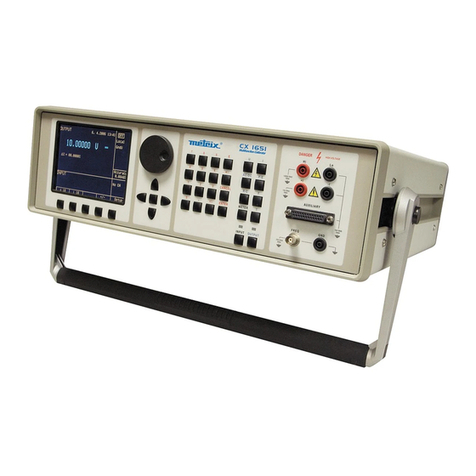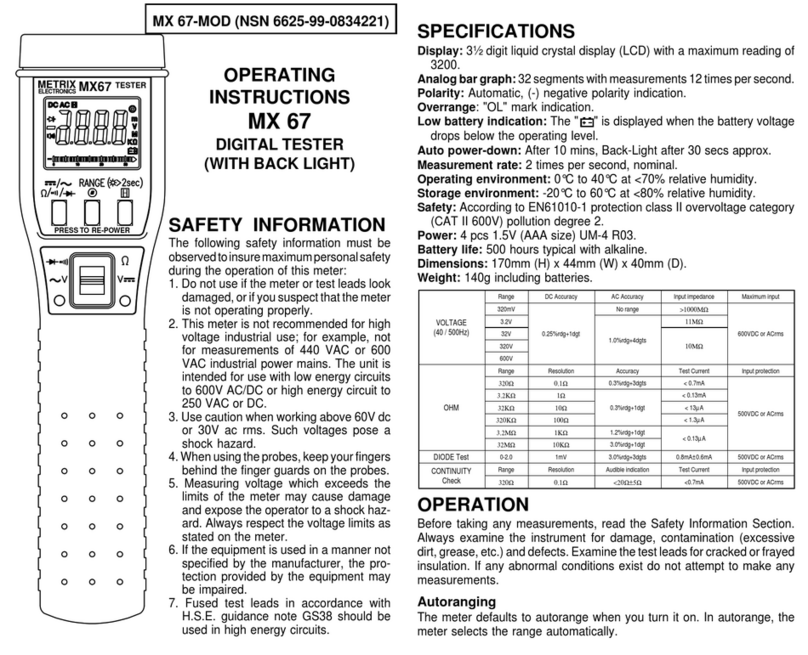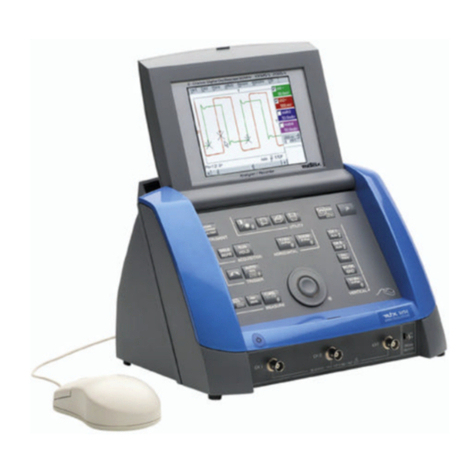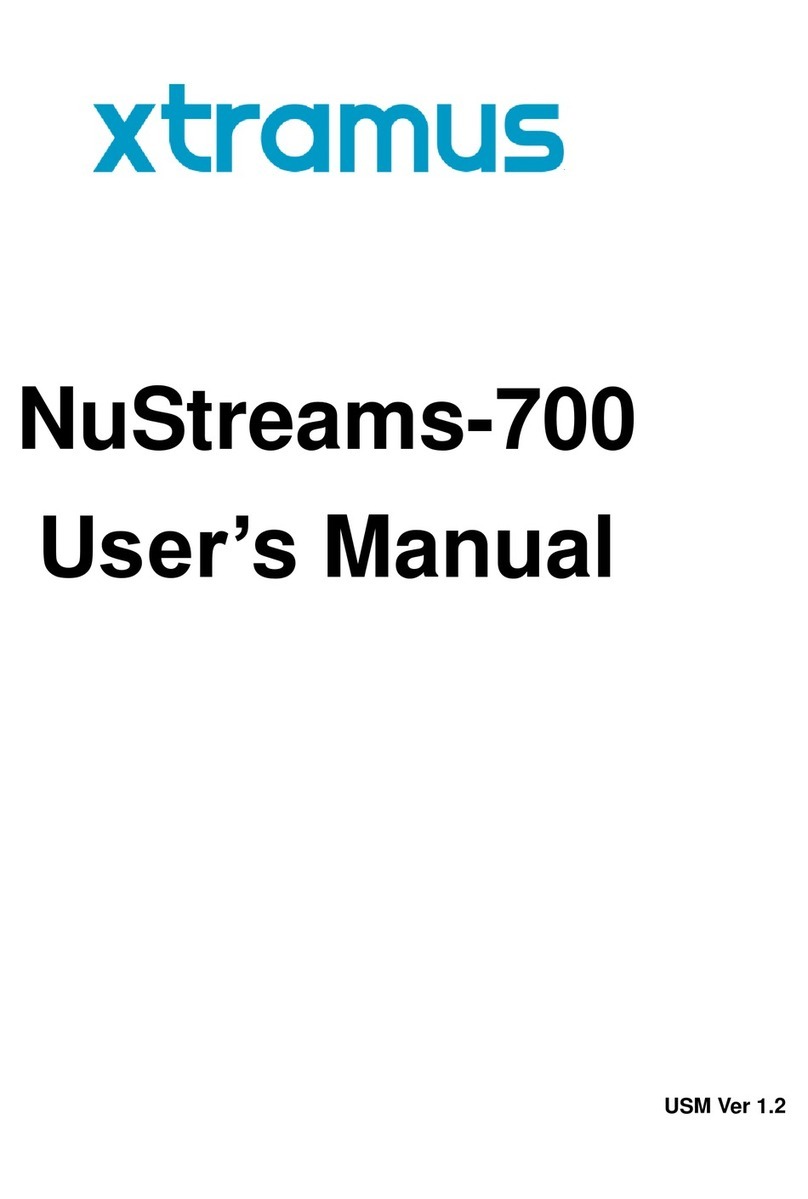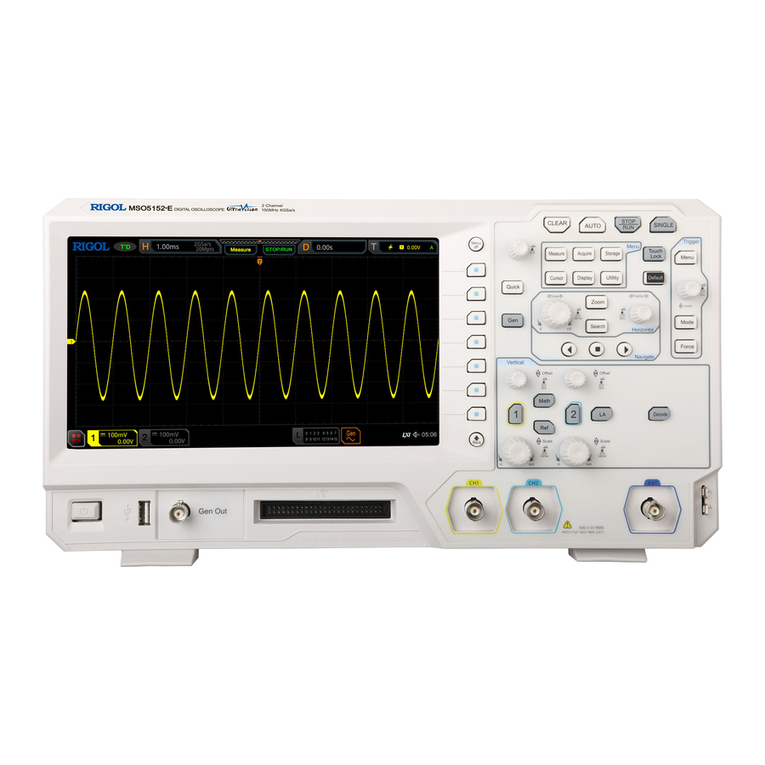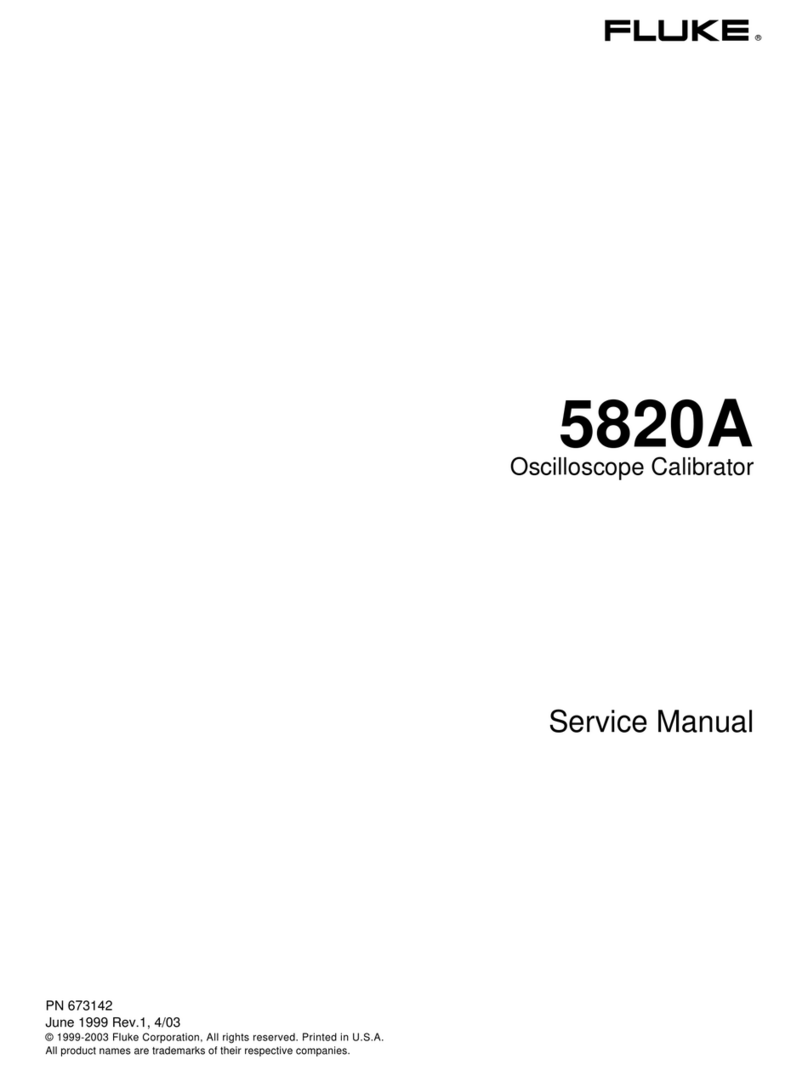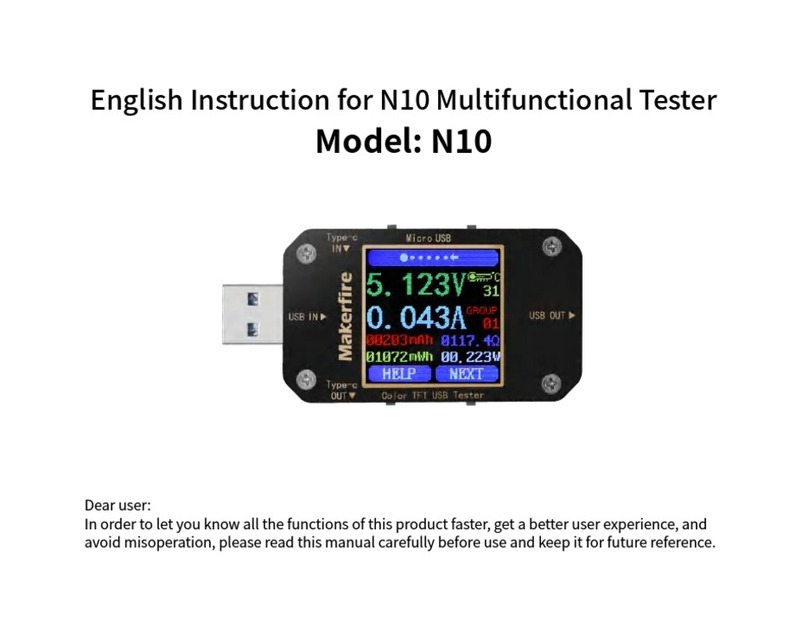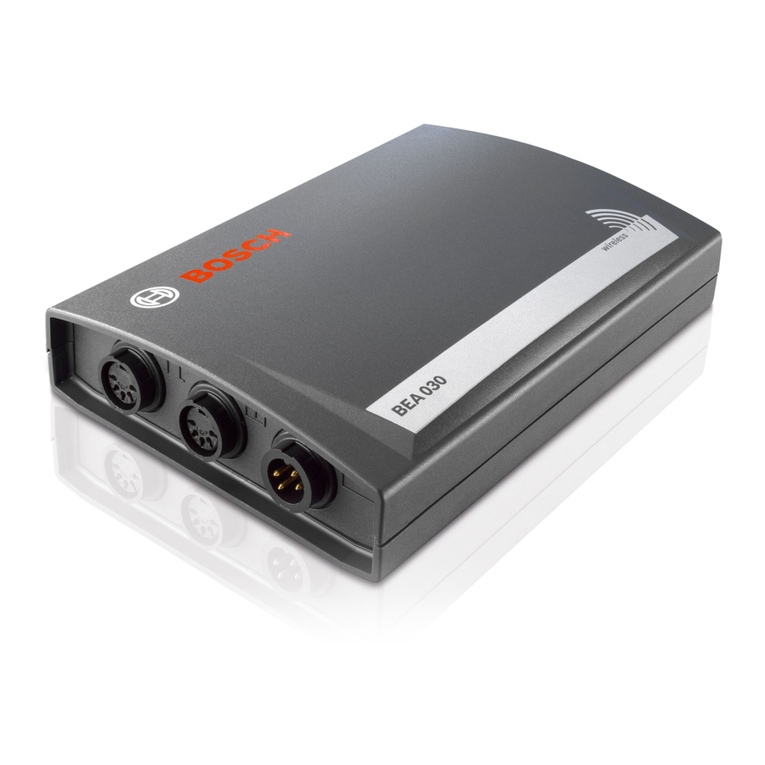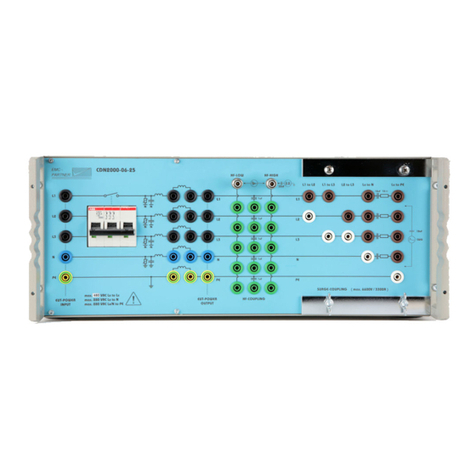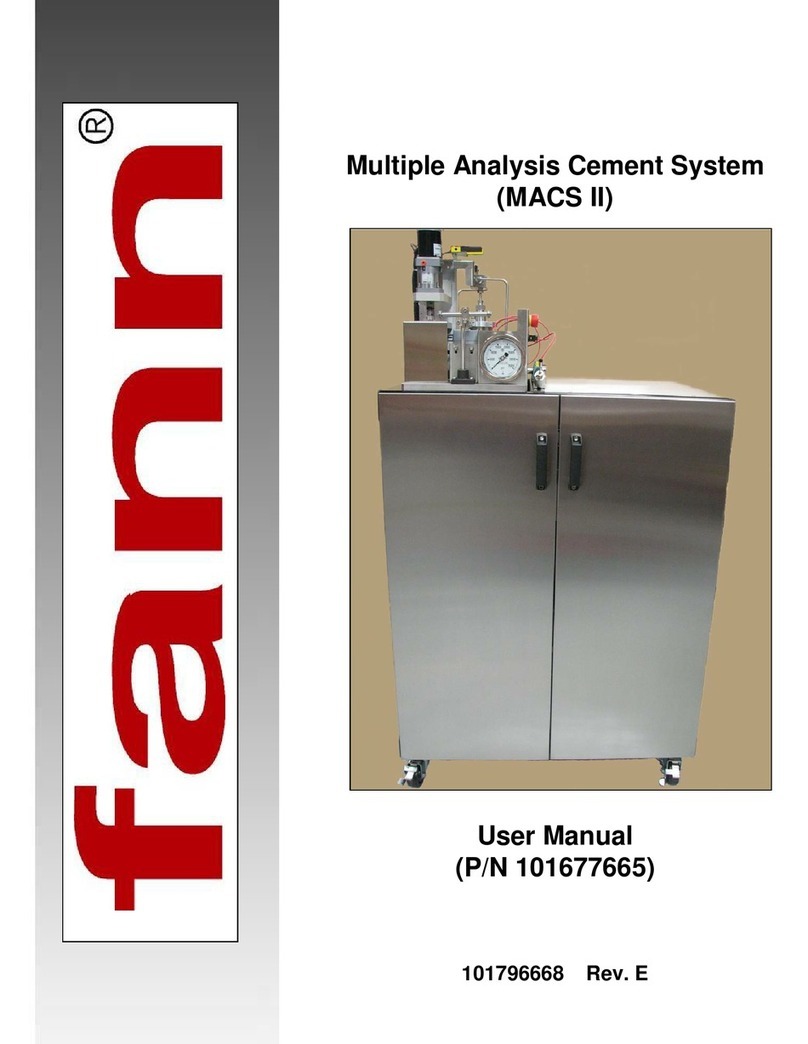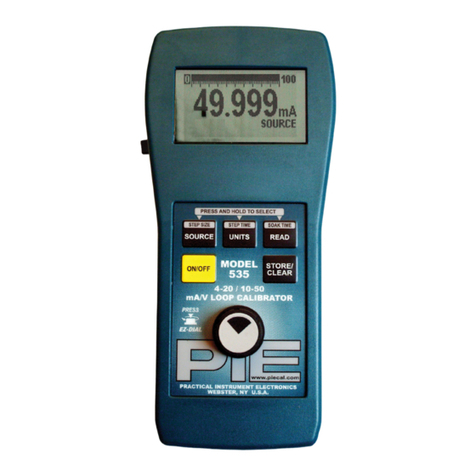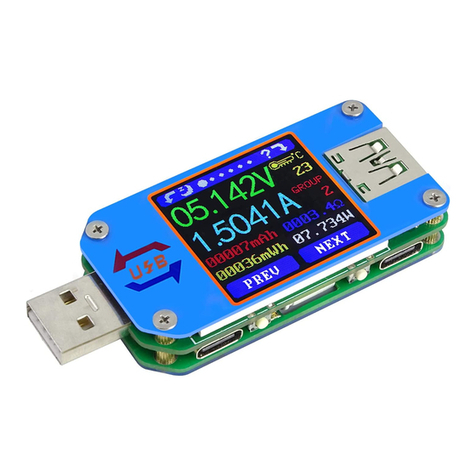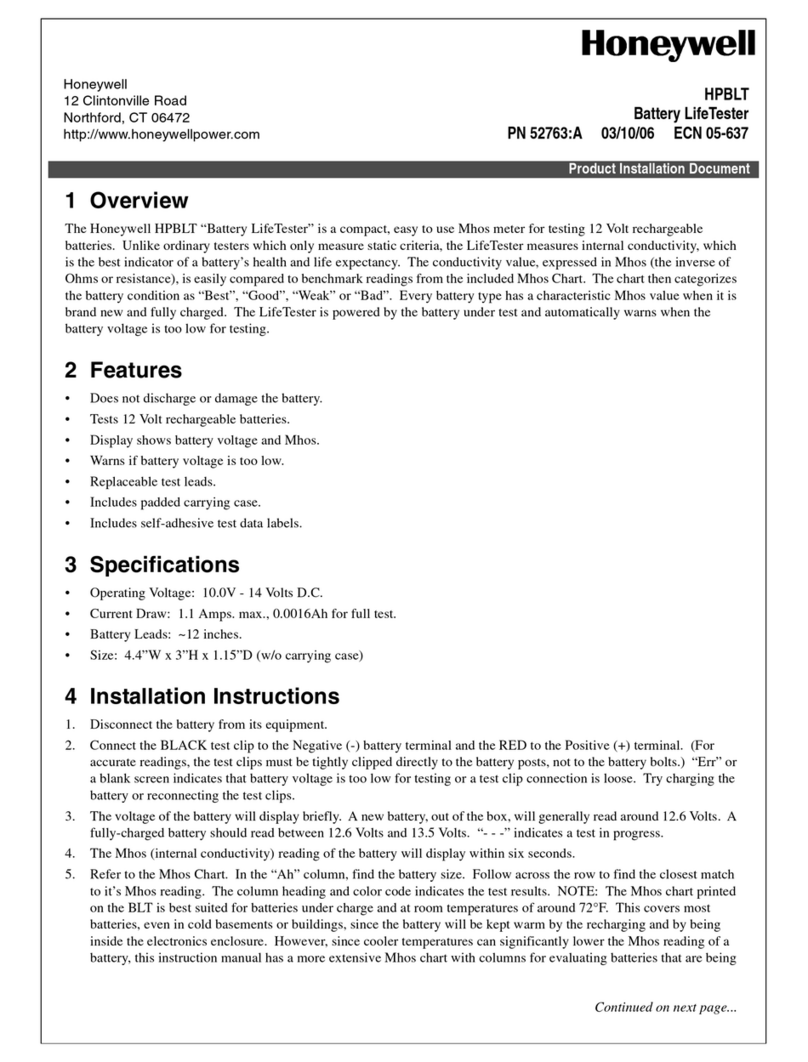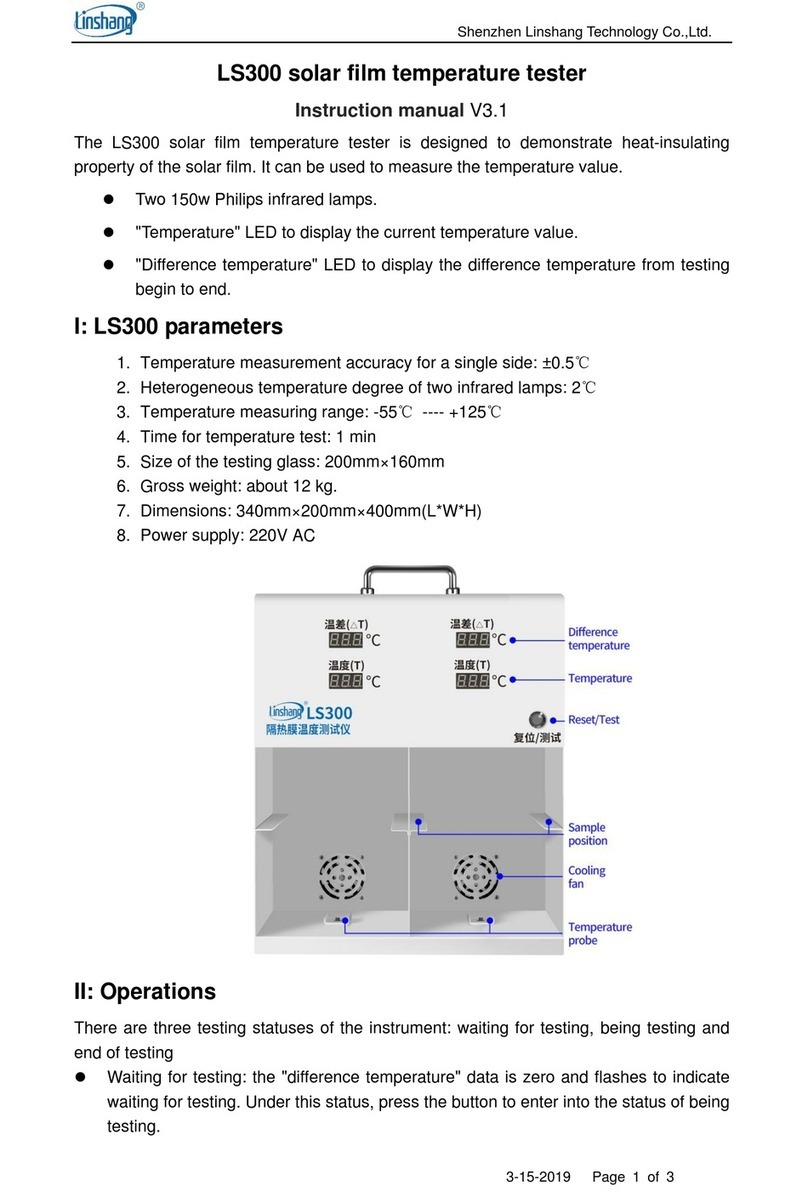Metrix HI-903 User manual

HI-903 HARDY SHAKER
Installaon Manual
DOC# 100928 • REV A (October 2017)
1180
1. OVERVIEW
The METRIX Model HI-903 Portable
Vibraon Calibrator provides a eld
tested method for on-the-spot dynamic
vericaon of accelerometers, velocity
pickups and non-contact displacement
transducers. Oponal mounng xtures
and hardware needed to connect
transducers to the HI-903 mounng
plaorm are available upon request.
A closed-loop control algorithm provides
enhanced stability and accuracy of
frequency and amplitude levels.
The HI-903 incorporates a built-in
sine wave oscillator, power amplier,
electrodynamic shaker, NIST traceable
reference accelerometer, digital display,
and internal memory. The HI-903 is
completely self-contained and operates
on baery or AC power.
The built-in reference accelerometer
is aached permanently to the shaker
armature, maximizing the accuracy
between the reference accelerometer
and the test transducer. The HI-903 is
designed to provide long-term reliable
performance over the frequency range of
7 Hz to 10 kHz. The HI-903 can be used
for a variety of applicaons that include:
• Vericaon and calibraon of
vibraon transducers and related
vibraon test systems
• Vericaon of connector and cabling
integrity
Conrm machine vibraon alarm trip
points are set properly and ensure
end-to-end funconality of vibraon
monitoring systems.
Notes
• Loads of up to 800 gram (28.3
oz) can be mounted directly to
the HI-903 mounng plaorm.
Larger loads may be applied to the
plaorm, however, if prolonged
tesng of a heavy load is planned,
we recommend using an external
transducer suspension system.
Under these condions the vibraon
waveform should be viewed on the
oscilloscope to aid in posioning
the test transducer and plaorm to
reduce distoron that can occur with
very heavy weights.

Doc# 100928 • HI-903-Shaker • October 2017-RevA Page 2 of 33
• The HI-903 should always be operated on a stable, at surface.
The HI-903 is designed for eld test applicaons but care must be taken to maintain
the integrity of the mounng plaorm assembly
• Hearing protecon recommended when operang the HI-903 for an extended
amount of me
Accessories
Accessories pictured below are included with each HI-903 Portable Vibraon Calibrator.
Mounng Wrench
1-Mounng Pad
2-1/4-28 to 1/4-28 Adapter
3-10-32 to 1/4-28 Adapter
Universal Power Supply and Plug Adaptors Acessory Pouch
USB Flash Drive Pre-Loaded with Report Generang Worksheet
12
3

Doc# 100928 • HI-903-Shaker • October 2017-RevA Page 3 of 33
2. BASIC OPERATION
For the basic operaon of the HI-903, a vibraon sensor and appropriate cable
are needed. Typically the HI-903 is used as a vibraon excitaon source and as a
readout device with the vibraon sensor connected to the HI-903’s Test Sensor BNC
Input. Alternavely, the HI-903 unit can be used to test dierent types of vibraon
equipment (i.e. a vibraon meter or vibraon monitoring system), in which case
the sensor will be directly connected to the vibraon measurement equipment and
the HI-903 is used just as a controlled excitaon source.
Test Setup
1. Mount your sensor to the HI-903 mounng plaorm
• The HI-903 sensor mounng plaorm is threaded for a ¼-28 stud. Select
an appropriate adaptor for mounng the sensor.
• While ghtening the sensor, secure the HI-903 mounng plaorm with
the supplied wrench to prevent damage from torque
2. Connect sensor under test (SUT) to “Test Sensor In.” Make sure that
connecons are secure.
3. Power the unit ON by pressing and holding the FREQUENCY dial for 3 seconds.
NOTE: It is good pracce to perform calibraons on baery power. Disconnecng
from line power ensures a power surge will not cause the calibrator to power down
during test. If excess current is detected during use, the portable calibrator shuts
down to prevent damage.
Selecng Input Mode
4. The HI-903 can accept ICP® as well as AC voltage and AC current output
sensors. Press and hold the AMPLITUDE dial to select between ICP®, Voltage Mode
or Modulated Current mode. Modulated Current mode is only available if the 9110-
MC rmware opon is ordered, otherwise user will not see this mode as an opon.
Note: ICP® (or IEPE) mode sensors are the most popular type of accelerometer
transducers and require a 2 mA to 20 mA constant current supply to operate.
The HI-903 unit supplies the necessary constant current to power this class of
sensors. Voltage output sensors are typically moving coil velocity sensors but
can also be the voltage output of a signal condioner associated with any type
of vibraon transducer such as the output from the probe driver in a proximity
probe system. Refer to the Sensor Signal Measurement Electronics (SUT Input
Characteriscs and Consideraons) for details.
Seng the Frequency and Amplitude Units
5. Select the correct Frequency Units for your test by pressing the FREQUENCY
dial to enter into the CALIBRATION OPTIONS menu:
• Use the FREQUENCY dial to highlight TEST SETTINGS then press.
• Within the Test Sengs Menu rotate the FREQUENCY dial to
highlight FREQUENCY UNIT then press to toggle between Hertz and
CPM.
6. Select the correct Amplitude Units for your test by pressing and releasing the
AMPLITUDE dial. The following opons are available:

Doc# 100928 • HI-903-Shaker • October 2017-RevA Page 4 of 33
Acceleraon Velocity Displacement
g’s pk
g’s RMS
m/s2 pk
m/s2 RMS
in/s pk
in/s RMS
mm/s pk
mm/s RMS
mils p-p
µm p-p
7. Select the desired vibraon amplitude and frequency for tesng by turning the
AMPLITUDE and FREQUENCY dials clockwise to increase or counter clockwise to
decrease the seng.
•Slow Turns – sengs will increase or decrease by single steps
•Fast Turns – sengs will increase or decrease by larger increments
Record and Save Calibraon Points
8. Once the frequency and amplitude are set to desired values, with the le
menu set to “Save Point,” press the FILE dial to store the calibraon data point.
9. Repeat steps 7 through 9 to set the frequency and amplitude to increment to
the next calibraon data point and save.
Compleng and Storing Record to Memory
10. Once all data points have been saved in a record and record is complete, rotate
FILE dial and press it to select “End Record.”
• The screen will prompt with:
11. Rotate the FILE dial to “Edit” to enter the model number, serial number and
axis. The FILE menu for this screen also includes the tools “Next” and “Back.”
• Push the FILE dial to choose “Next,” which goes to the next save
screen.
12. To “Save” the record without inpung an annotaon, press the FILE dial two
more mes.
13. Rotate the FILE dial to “Edit” and press to store any annotaons or addional
notes (such as technician inials, etc):
• Turn the FILE dial to the le and right to select each individual leer
or number you wish to input as part of an annotaon. Push the FILE
dial to save each character.
• Rotate the FILE dial and select “Save.” This will save all data points in
the listed record number. The record number shown on the screen
increments automacally.

Doc# 100928 • HI-903-Shaker • October 2017-RevA Page 5 of 33
Transfer Records to USB Flash Drive
14. Rotate FILE dial and press to select “Tools.”
15. Rotate FILE dial and press to select “USB Menu.”
• A USB ash drive must be connected to the unit. The USB must be
formaed to FAT32. You can use the HI-903 or a PC to format the
ash drive.
16. To copy all data points and records to a USB Flash Drive, rotate FILE dial and
press to select “Copy All Records.”
• This will leave current records on unit memory and also create a
copy on the USB.
17. To move all data points and records to USB, rotate FILE dial and press to select
“Move All Records.”
• This will remove current records on unit memory and move onto the
USB.
Note: The USB hardware may not always recognize a USB ash drive if it is plugged
into the USB port while the HI-903 is in sleep mode. Metrix recommends connecng
the USB drive while the HI-903 is on and operaonal.
Powering O
18. Suggested Best Pracce: Before powering the unit OFF, reduce the vibraon
amplitude. The HI-903 retains the sengs used prior to shutdown when it
is powered back ON. Reducing the amplitude prior to shutdown ensures the
sensor under test will not be jarred when the HI-903 is powered ON.
19. Power the unit OFF by pressing and holding the FREQUENCY dial for
approximately 3 seconds.
• To preserve baery charge, the HI-903 will automacally power o
aer 20 minutes of inacvity when not plugged in to the charger.
Aer Tesng
20. Suggested Best Pracce: Plug the HI-903 into an AC power source when not in
use. This will ensure the baeries are fully charged for your next test and also
help to maximize the lifespan of the baeries.
21. Periodic calibraon checks are recommended:
• A dedicated “vericaon sensor” can be used to check the system
readings and results. By using a dedicated sensor, you can ensure
that the system is providing the same result during each test. Metrix
oers Model 9105D for this purpose. (The 9105D includes a transfer
standard reference accelerometer and ICP sensor signal condioner,
for system vericaon of portable vibraon calibrators).
• The HI-903 should be returned to Metrix for regular recalibraon
(recommended annually - Service Code 9100-CAL01) or for any
maintenance or repair. The most current factory calibraon date or
the calibraon due date is displayed on the LCD screen during the
HI-903 boot up sequence. The default due date is set for 12 months
aer the last factory calibraon, but the calibraon interval can be
user dened to be anywhere from 1 to 72 months, or set up to never
expire.
• NOTE: The aforemenoned Model 9105D allows users to duplicate
Metrix’s calibraon process without returning the shaker to the
factory.

Doc# 100928 • HI-903-Shaker • October 2017-RevA Page 6 of 33
Report Generaon Workbook
Calibraon data can be saved into the HI-903’s internal memory and easily
exported to a personal computer using a USB Flash Drive.
The HI-903 Portable Vibraon Calibrator includes a pre-formaed USB Flash
Drive with a Microso Excel Report Generaon Workbook for the creaon of
customizable calibraon cercates. The Excel le provides an intuive interface
which allows a user to create and print a calibraon cercate with just a few
mouse clicks. In order to use the le, make sure macros are enabled, otherwise
Excel won’t be able to load data and create the cercates.
The Excel workbook consists of the following worksheets or tabs:
• FRData – Use this tab to create a frequency response cercates in just 2
steps:
1. Clicking on Import Data from File buon prompts the user to select and import
a .pvc calibraon data le previously created by the HI-903
2. Once data is loaded into the table, click View Cercate to see and print a
calibraon cercate containing the frequency response data (the reference
frequency for the calibraon cercate is 100Hz and can be changed by the
user as needed)
Note: If tesng a charge-mode accelerometer and calibraon cercate
in pC units is desired, click the box at top le of the FRData tab and enter
the sensivity of the charge amplier in the “mV/pC” box located at cell
D8. See the secon “Calibrang Charge-Mode Accelerometers” for more
informaon.
• LINData – Use this tab to create linearity response cercates. The worksheet
applies linear regression to interpolate the data. The Max Linearity is calculated
for the worst deviaon of a parcular point from the best-t straight line (BFSL)
of all tested points. The table also displays the specic results at each test level.
The LINData worksheet has 2 tables. The le table should be used for creang
dynamic linearity data calibraon cercates in just 2 steps:
1. Click on Import Data from File to select and import a .pvc calibraon data le
previously created by the HI-903
2. Once data is loaded into the table, click View Cercate to see and print a
calibraon cercate containing the linearity response data. The worksheet
expects the data points to be taken at the same frequency (speed). A checkbox
opon labeled Set Y-intercept to zero is available to force the interpolaon to
go through the origin point.
The right table in the LINData worksheet is used to create a DC proximity probe
curve or linearity cercate for 4-20 mA vibraon transmier. Creang a DC
proximity probe curve requires the proximity probe adaptor kits and a DC
voltmeter (not included). Creang a linearity cercate for a 4-20 mA vibraon
transmier requires DMM set to DC current input. A 24 VDC power supply may
also be needed:
1. Select the appropriate vibraon scale (Acceleraon, Velocity or Displacement)
by clicking in cell H12 and selecng from drop down menu.
2. Select the appropriate units (g’s pk, g’s RMS, m/sec2 pk, m/sec2 RMS, in/sec pk,
in/sec RMS, mm/sec pk, mm/sec RMS, mils p-p or µm p-p) in cell H13. Make
sure cell H12 is set to the right scale rst.
3. Enter known amplitude and output for the rst test point next to “Starng
Point” and repeat for each addional test point moving down the table.
Once data is entered into the table, click View Cercate to see and print a
calibraon cercate containing the linearity response data.
• FRCert - Displays the frequency response calibraon cercate using the

Doc# 100928 • HI-903-Shaker • October 2017-RevA Page 7 of 33
current data and informaon from FRData.
• LINCert - Displays the linearity response calibraon cercate using dynamic
linearity data from LINData.
• SLINCert - Displays the linearity response calibraon cercate using stac
linearity data from LINData.
• Route Creator – If rmware opon HI-903 CALROUTE is ordered, this tab can
be used to create semi-automated tests with instant pass/fail nocaon for
almost any vibraon sensor. See “Calibraon Route” for more informaon.
Addional Features
Delete
The “Delete” feature can be found under the FILE dial > “Delete.” When “Delete” is
selected, the shaker will stop moving and four opons will appear:
1. “Delete Point” will delete a current point.
2. “Delete Record” will delete the enre current record.
3. “Delete All” will delete all data points and all records that are stored on the
internal unit memory.
4. “Back” will return to the main screen.
USB Opons
The “USB Opons” feature can be found under the FILE dial > “Tools” > “USB
Menu” > “USB Opons.” When “USB Opons” is selected, the following
informaon will appear on the screen:
• “Status” – USB ash drive connected or not connected.
• “Paron” – Format of USB ash drive connected to the unit.
• “Available” – Memory space available on USB ash drive.
• “Required” – Space required to save all records on USB ash drive.
And the following acons are available:
• “Eject Drive” will safely eject the USB ash drive from the unit.
• “Format USB” for formang the USB ash drive. (FAT32 paron)
• “Back” to go back to the USB Menu.
Date and Time
The “Date and Time” feature can be found under the FILE dial > “Tools” > “Opons”
> “Date and Time.”
1. Press the FILE dial to select “Adjust.”
2. Turn the AMPLITUDE dial to the select the current month, day and year and
push the FREQUENCY dial to conrm or the AMPLITUDE dial to change.
3. Press the AMPLITUDE dial to select “yes” this is correct.
4. Turn the AMPLITUDE dial to select the current hours and minutes then push
the FREQUENCY dial to conrm the me is correct.
5. Press the AMPLITUDE dial to select “yes” this is correct.
Calibraon Interval
The “Calibraon Interval” can be adjusted under the FILE dial > “Tools” > “Opons”
> “Calibraon Interval.”
1. Select “Adjust” and press FILE dial.
2. Turn AMPLITUDE dial to select number of months for Calibraon Interval.
• Suggested Best Pracce: 12 months. The calibraon interval can be
dened to be anywhere from 1 to 72 months, or set up to never expire.
3. Press FREQUENCY dial to conrm selected Calibraon Interval.

Doc# 100928 • HI-903-Shaker • October 2017-RevA Page 8 of 33
Traceability
The “Traceability” feature can be found under FILE dial > “Tools.”
1. Press FILE dial to select “Traceability.” A screen with the following informaon
will appear:
• Model
• Serial Number
• Firmware Revision Number
• Calibraon Date
• Reference Sensor Sensivity
• PRD-P
• NIST Traceability Number
• PTB Traceability Number
2. Press FILE dial to go back to main screen and shaker will go back to shaking.
Test Sengs
The “Test Sengs” menu can be found by pressing FREQUENCY dial > “Test
Sengs.” A screen with the following will appear, use the FREQUENCY dial to
highlight and toggle all sengs:
• Back – returns user to “Calibraon Opons” menu
• Cal Route: N/A, Acve or o
o N/A indicates the Calibraon Route rmware opon has not
been purchased. Calibraon Route allows users to program semi-
automated test points with instant pass/fail nocaon. See
“Calibraon Route” secon for more informaon. Contact Metrix
to unlock this feature.
• Source: Internal or External
o If external is selected the shaker can be controlled with an external
source. See “Input/Output” for more informaon.
• Frequency Unit: Hertz or CPM (cycles per minute)
• Sensor Type: ICP®, Voltage or Modulated Current
o Use ICP® for most accelerometers, Voltage for proximity probes
and moving coil sensors, Modulated Current for high-temp turbine
vibraon sensors with AC current output. See “Selecng the Input
Mode” for more informaon. Modulated current is oponal;
contact Metrix to unlock this feature.
• Sensor Readout: mV/EU or mV
o Changes the display to show the sensor under test’s sensivity
(output voltage divided by input vibraon, mV/EU) or the sensor
under test’s raw AC output voltage.
Amplitude Units
Amplitude units that are seldom or never used can be turned o by using the
“Amplitude Units” feature, found by pressing FREQUENCY dial > “Amplitude Units.”
The “Amplitude Unit Screen” shows all 10 available amplitude scales on model
HI-903 Portable Vibraon Calibrator. Use the FREQUENCY dial to highlight each
scale and press the dial to toggle the scale on or o. A lled circle next to the
scale indicates it is acve. An empty circle next to the scale indicates it is inacve.
Inacve scales do not appear when cycling through scales using the AMPLITUDE
dial during normal operaon.

Doc# 100928 • HI-903-Shaker • October 2017-RevA Page 9 of 33
To go back to the “Calibraon Opons” menu use the FREQUENCY dial to highlight
“Back” then press.
Calibraon Route
Firmware Opon: HI-903 CALROUTE
Model HI-903 must be ordered with rmware opon 9110-CALROUTE for the
Calibraon Route features to be available. This rmware can be added at any me.
Contact Metrix for ordering and installaon informaon.
The Calibraon Route rmware allows users to create and run semi-automated
frequency response and amplitude linearity tests for vibraon sensors on model HI-
903 with instant pass/fail nocaon. Tests or “routes” are created in the Report
Generaon Workbook then uploaded to the HI-903 via supplied USB drive. Once
uploaded the test is acvated. But the test can also be de-acvated at any me,
pung the HI-903 back into manual operaon mode. When a Calibraon Route
is acve the HI-903 can only adjust to the pre-dened amplitude and frequency
points that have been programmed.
Creang A New Test (Route)
Version 2010 or later of Microso Excel® is required for the CalRoute features
in Report Generaon Workbook to operate correctly. Drop-down arrows for
frequency and amplitude units may not appear if using older versions of this
soware.
1. Open the Report Generaon Workbook (version 3.0.2 or later required)
using Microso Excel®
2. At boom, select the Route Creator tab
3. Route Name: Enter the name of the test in cell B7 next to “Route Name”.
When the test le is created and saved the le name will be this value
followed by “_Route.pvc”.
4. Frequency Unit: Use the drop down arrow to choose the frequency unit
(Hertz or CPM) in cell B8. One cannot toggle between Hertz and CPM
during the test.
5. Amplitude Unit: Use the drop down arrow to choose the amplitude unit
(g pk, g RMS, m/sec2 pk, m/sec2 RMS, in/sec pk, in/sec RMS, mm/sec pk,
mm/sec RMS, mils p-p or µm p-p) in cell D7.
6. Amplitude: If desired, enter the amplitude for all test points in cell B9 next
to “Amplitude”. This is useful for a frequency response test where all test
points will have the same amplitude value. If creang a linearity test leave
this cell blank since the amplitude values will change for each test point.

Doc# 100928 • HI-903-Shaker • October 2017-RevA Page 10 of 33
7. Sensor Type: Use the drop down arrow in cell F7 to select the sensor type
(ICP®, Voltage or Modulated Current).
8. Sensor MN: if desired, enter the sensor model number in cell F8. This
is oponal. The sensor model number that is entered will print on the
calibraon cercate. It can be changed at any me. If the model number
is not consistent leave this cell blank.
9. Lower Bound: in cell D8 enter the minimum sensivity value for the
sensor under test at each test point that will pass calibraon test. For
example, the minimum acceptable sensivity for 100 mV/g accelerometer
with +/- 5% sensivity tolerance is 95 mV/g, thus lower bound would be:
95.00.
10. Upper Bound: in cell D9 enter the maximum sensivity value for the
sensor under test at each test point that will pass calibraon test. For
example, the maximum acceptable sensivity for 100 mV/g accelerometer
with +/- 5% sensivity tolerance is 105 mV/g, thus upper bound would be:
105.00.
11. Press Table Auto-Fill. The grey cells in the table will automacally
populate with the values chosen in steps 3-10. All cells will populate. The
table is capable of creang a 30-point test. But any number of test points
can be programmed. Before creang the route le user must delete values
in cells for test points that should not be created (see example).
12. Enter the desired Frequency values for each test point in column A
beginning with cell A13. The test will be conducted in the exact order as
programmed. The rst test point will be as programmed in row 13; the
next will use row 14 values and so on.
a. The HI-903 can only simulate vibraon in CPM values that are
mulples of 60. I.e. 1800 CPM, 3600 CPM, 4200 CPM, etc. If a
value is entered that is not a mulple of 60, the HI-903 will adjust
down to the nearest CPM value that is a mulple of 60.
b. Example: 1900 CPM is entered as a test point. The HI-903 will
adjust to 1860 CPM and 1860 CPM will be displayed.
13. Enter the desired Amplitude values for each test point in column B
beginning with cell B13. Skip this step if all amplitude values have been
automacally populated using the Table Auto-Fill buon.
14. Modify any individual test point as desired. For example, most
accelerometers have a wider sensivity tolerance at extreme low and high
frequencies. User may wish to expand the upper and lower bounds for
certain test points.
15. Delete undesired test points. For example, a 10-point test only requires
rows 13-22. The Table Auto-Fill feature saves typing but one must delete
data from cells that are not needed. For a 10-point test rows 23-42 should
be blank thus they can be highlighted and cleared.
16.Press Create Route File. A .pvc le will be created, save this le to the USB
drive in the Calibraon_Route folder.
a. When prompted to save, open the USB Disk
b. Open the METRIX_PVC folder
c. Open the Calibraon_Route folder
d. Press save

Doc# 100928 • HI-903-Shaker • October 2017-RevA Page 11 of 33
Example Accelerometer Test (Route)
An example of a 10-point accelerometer test, created in the Report Generaon
Workbook, is shown above. Some helpful notes…
• When run, this test will shake the accelerometer at 1g pk at all points. If
the shaker cannot generate 1g pk it will output the maximum vibraon
possible given the sensor’s weight and test speed. The shaker will not
allow user to program points that can damage the shaker.
• The test will begin at 10 Hz and end at 5000 Hz, with test points at
50,100, 300, 500, 1000, 2000, 3000 and 4000 Hz as well.
• If the sensor under test’s sensivity is above 105 mV/g or below 95 mV/g
the HI-903 will alert the user that test point failed.
• The le name will be CaseAccel_Route.pvc, when uploading to the HI-903
one would choose this le.
• ICP® power is acve for all test points. If this test were applied to a self-
powered sensor data would be invalid. One would select “Voltage” for a
self-powered sensor such as a moving coil velocity transducer.

Doc# 100928 • HI-903-Shaker • October 2017-RevA Page 12 of 33
Example Proximity Probe Test (Route)
An example of a 10-point proximity probe test, created in the Report Generaon
Workbook, is shown above. Some helpful notes…
• This test will simulate vibraon at 3600 CPM for all test points.
• This is a linearity test. Vibraon will start at 1.0 mils p-p and escalate to
10.0 mils p-p. The sensor will be evaluated every 1.0 mils.
• The test is designed for a 200 mV/mil proximity probe with 5% tolerance.
Thus sensivity of 190-210 mV/mil passes calibraon. If outside those
values the HI-903 will indicate the test point has failed.
• The sensor type is voltage. This means ICP® power is turned o. The
proximity probe is being powered by its probe driver. To run this test the
technician must connect the output of the probe drive to “Test Sensor In”
on the HI-903.
• The name of the le will be ProxProbe_Route.pvc.
• The model number 330101 will print on each test report created using
this route. It can be modied on the cercate if desired to add thread
lengths, cable length, etc.
Loading & Acvang a Calibraon Test (Route)
With the calibraon test saved as a .pvc le to the Calibraon_Route folder on the
USB and the USB inserted into the port on the HI-903 the following instrucons
detail how to upload to model HI-903 and acvate:
1. Press the FREQUENCY dial to enter “Calibraon Opons” menu, rotate to
highlight TEST SETTINGS and press again to enter “Test Sengs” menu.
2. Use FREQUENCY dial to highlight and click selecon next to “Cal Route:”.
Selecon will be “O” or “Acve” depending upon previous status. When
clicked user will enter into “Route Opon” menu.
a. If display indicates “Cal Route: n/a” the HI-903-CALROUTE
rmware has not been purchased. Contact Metrix to add this
rmware to the HI-903.
3. Use FREQUENCY dial to highlight and click on LOAD FILE FROM USB
4. Up to six route les (tests) are shown. Use FREQUENCY dial to highlight
and click on desired le.

Doc# 100928 • HI-903-Shaker • October 2017-RevA Page 13 of 33
5. Display will indicate “Route Load Successful Acvate Now?” To acvate
press the AMPLITUDE dial.
a.To load to memory but not acvate the test press FREQUENCY.
The calibraon test is now loaded and acve. Rotang the FREQUENCY dial allows
user to scroll through programmed test points without saving data.
Execung the Semi-Automated Calibraon Test (Route)
The calibraon test has been created and saved to the USB. It has also been
uploaded and acvated in the HI-903 using the previous secon. The following
instrucons detail usage of the HI-903 while the pre-programmed test is acve. To
use the HI-903 in manual mode again the calibraon route must be de-acvated
(see next secon).
• With a Calibraon Route acve the HI-903 will only cycle to the pre-
programmed test points. The FREQUENCY dial can be used to cycle and
preview test points without saving data.
• Pressing the amplitude dial will not change amplitude scales while route is
acve.
• Data is sll stored to internal memory when Calibraon Route is acve if
FILE dial is pressed while “Save Point” is displayed. Delete, Save, Tools and
End Record funcons operate as previously detailed in “Basic Operaon”
secon.
1. Once the Calibraon Route is acvated shaker will vibrate at rst pre-
programmed test point. Use FILE dial to display “Save Point” then press
the dial.
2. A pass/fail indicaon is displayed. The frequency, amplitude, sensivity
of sensor under test, upper and lower bounds are shown. If sensivity
is between upper and lower bounds “Pass” is shown at top right. If
sensivity is outside of bounds “Fail” is displayed. Press FILE dial to
connue to next test point.
a. If test point fails technician can delete the point and try again
by using FILE dial to display “Delete” then press and make
appropriate selecon. Deleng the point will step the test back
to the previously failed test point.
3. Connue the test point-by-point by pressing the FILE dial with “Save
Point” displayed. The pass/fail screen will appear aer each point.
4. When test is complete the model and serial number entry screen is
displayed. Enter data as outlined in “Basic Operaon” secon or skip by
pressing FILE with “Next” displayed.
5. A nal data entry screen is displayed, with “Save” displayed press FILE to
save the calibraon test results to internal memory and begin next test.

Doc# 100928 • HI-903-Shaker • October 2017-RevA Page 14 of 33
Creaon of print-able test reports is done as previously menoned. Follow
instrucons in “Basic Operaon” secon to create frequency response and linearity
calibraon cercates in Microso Excel®.
Route Opon Menu
The Route Opon menu is accessed by pressing FREQUENCY dial then using the
dial to highlight and click on Test Sengs, then using the dial to highlight the text
next to Cal Route: and clicking on it. The menu has the following funconality and
the FREQUENCY dial is used to navigate and select:
• Back – returns to Test Sengs menu
• Acvate Route – acvates the calibraon test stored in memory
• Deacvate Route – returns the HI-903 to manual operaon, de-acvates
semi-automated test
• Load File From USB – shows a list of up to six pre-programmed tests
(routes) read from Calibraon_Route folder on USB drive
• Delete Route – returns the HI-903 to manual operaon and also deletes
the pre-programmed test from memory
• File Informaon – displays name of semi-automated test, number of test
points and date it was created. If no test is acve pressing le while this
opon is highlighted does nothing.
• Eject USB – allows user to safely remove the USB drive from HI-903
Denion of Frequency Units
• Hertz (Hz) is dened as the number of periodic cycles per second and it is
a standard unit for measuring signal frequency.
• CPM stands for Cycles Per Minute. CPM is commonly used for tesng
industrial sensors that monitor rotaonal vibraon. 1 Hz=60 CPM
Denion of Amplitude Units
• Root Mean Square (RMS) is a calculaon that takes the square root of
the average of the squared amplitudes from a set of data. This type of
measurement takes all amplitudes of a signal into account rather than just
one, making it an accurate tool for an overall calculaon.
• Peak (pk) bases calculaons on the highest value of the signal generated
during tesng. For a sinusoidal wave (as is produced by the HI-903), the
peak value is calculated by RMS* . The HI-903 does not measure a true
Figure: Sinusoidal Wave

Doc# 100928 • HI-903-Shaker • October 2017-RevA Page 15 of 33
peak value, but instead esmates the value mathemacally based upon
the RMS value.
• Peak to Peak (p-p) is a calculaon of the dierence between the highest
posive peak and the lowest negave peak of a recorded sine wave. The
p-p value is calculated as two mes the peak value.
• Gravitaonal acceleraon (g) is the acceleraon experienced naturally by
objects in earth’s gravitaonal eld. It is approximately equal to
9.80665 m/s2.
Mounng Basics
Connecng Sensor to HI-903 Plaorm
1. Mang surfaces of the mounng plaorm and sensor should be at,
parallel and free of dirt, paint, epoxy, scratches, etc.
2. Threads in plaorm, sensor and adaptor (if needed) must match to ensure
a proper t and that tesng is free of errors. Clean any worn threads with
a tap or die and coat them in silicone grease for best results.
3. An adaptor may be needed to connect the sensor to the armature. The
HI-903 plaorm requires a ¼-28 thread.
4. Silicone grease can be applied to the mang surfaces and threads to
ensure good mechanical coupling. This is parcularly important when
tesng at high frequencies.
5. For threaded sensors, please follow the sensor manufacturer’s torque
recommendaon.
Tightening and Loosening Connecons
1. When ghtening or loosening the connecon between the sensor and
the HI-903 mounng plaorm, secure the mounng plaorm with the
supplied wrench.
2. It is important to keep sensors and xtures centered and straight when
aaching them to the HI-903 mounng plaorm. This will ensure a stable,
even connecon and eliminate potenal alignment issues.
Input / Output
EXTERNAL SOURCE IN Input BNC
It is possible to drive the HI-903 by using an external signal source or a funcon
generator. First, connect a signal source to the EXTERNAL SOURCE IN BNC Input
located on the top le corner of the unit. To enable the EXTERNAL SOURCE
IN input, press the FREQUENCY dial to enter the “Calibraon Opons” menu
then rotate FREQUENCY dial to highlight and click on TEST SETTINGS. Next, use
FREQUENCY dial to highlight selecon next to “Source:” and toggle between
“Internal” and “External” by pressing the dial, select “External”.
1. When in Ext Sig mode, the vibraon amplitude is measured and displayed on
the screen, however, the frequency and amplitude of the shaker is controlled by
the external source, not by the HI-903. The frequency of the input signal is not
displayed on this mode.
2. The amplitude and sensivity values displayed on the screen are for reference
only. The measurements are not accurate while in Ext Sig mode and do not fall
under the published specicaons for the product.

Doc# 100928 • HI-903-Shaker • October 2017-RevA Page 16 of 33
Do not exceed 1V RMS! Overdriving the unit may cause clipping,
unwanted distoron and damage to the unit
MONITOR REFERENCE OUT Output BNC
The HI-903 is controlled by an internal shear mode quartz reference accelerometer.
The voltage output of the reference accelerometer can be monitored through the
available MONITOR REFERENCE OUT BNC output by connecng it to a readout
device (e.g. voltmeter or oscilloscope).
Diagnosc Screen
The diagnosc screen can be displayed by holding down the le buon for
approximately 2 seconds. This screen displays informaon about the operaon of
the HI-903. The informaon found in this menu is displayed in real me:
Reference ICP Bias Voltage
Test Sensor Bias Voltage
Test Sensor Type: Voltage, ICP® or Modulated Current
Signal Type: Internal or External
Reference THD
Sensor THD
Exit the diagnosc screen by pressing the le buon.
TEST SENSOR IN Input BNC
The HI-903 provides the capability to measure the test sensor’s voltage signal,
replacing the need for an external DMM or data acquision. The input electronics
can be congured for Voltage, ICP® or Modulated Current mode as described in
Step 4 of Basic Operaon earlier in this manual.
The TEST SENSOR IN input BNC is capable of measuring a voltage input of up to
10V AC pk-pk. As an ICP® sensor signal condioner, it measures up to 10V pk-pk AC
signal while supplying 5mA ICP® constant current at 25V DC. While in ICP® mode,
the input circuit is also monitoring the ICP® sensor Bias Voltage and will indicate a
Bias Fault when the DC voltage is below 2V DC or above 15V DC. The open circuit
voltage of the ICP® supply will be 25V DC. This open circuit and the ICP® Bias
Voltage may be checked using the diagnosc menu.
3. THEORY OF OPERATION
Instrumentaon
The Model HI-903 Portable Vibraon Calibrator internal electrical system is
comprised of several dierent mechanisms:
• Electrodynamic Shaker
• Power Amplier
• Reference Accelerometer
• Signal Generaon Electronics
• Sensor Signal Measurement Electronics
• LCD Digital Display

Doc# 100928 • HI-903-Shaker • October 2017-RevA Page 17 of 33
• 3 Dials with Detent and Integrated Pushbuons
• 12 VDC, 4 Amp Hr Solid Gel Baery
• External Charger
• Three dierent BNC ports: “External Source In,” “Monitor Reference Out” and
“Test Sensor In”
• USB Flash Drive Port
The LCD display connuously shows the frequency of the shaker drive signal and
the vibraon amplitude of the mounng plaorm as measured by the reference
accelerometer.
The reference accelerometer is a PCB Piezotronics ICP® quartz shear sensor,
integrated into the mounng plaorm. A calibraon “standard” maintained by
METRIX is used to calibrate the HI-903 as a complete system and provides NIST
traceability. Traceability informaon can be viewed under the tools menu as
described in the previous secon.
The power amplier is specically designed to provide the current required to drive
the electrodynamic shaker. The electronic signal processing system produces a
variable frequency sine wave to the power amplier, which becomes the source of
the driving signal to produce the vibraon at the mounng plaorm.
The frequency of the shaker drive signal is controlled by the front panel
FREQUENCY dial. The amplitude of the shaker drive signal is controlled through a
feedback loop, to maintain the stability of the actual moon. Adjusng the front
panel AMPLITUDE dial adjusts the target vibraon amplitude.
Pressing the AMPLITUDE dial toggles the amplitude measurement units through
the following choices if all units are acve:

Doc# 100928 • HI-903-Shaker • October 2017-RevA Page 18 of 33
Acceleraon Velocity Displacement
g’s pk
g’s RMS
m/s2 pk
m/s2 RMS
in/s pk
in/s RMS
mm/s pk
mm/s RMS
mils p-p
µm p-p
Users can de-acvate amplitude scales by using the “Amplitude Units” menu.
See the secon “Amplitude Units” for more informaon. If desired scale is not
appearing while pressing AMPLITUDE to cycle through scales, then it has likely
been turned o in the “Amplitude Units” menu.
Turning the FILE dial acvates the le menu. Turn the FILE dial to toggle between
the below opons and press the dial again to select.
Save Point End Record Delete Tools
Next
Edit
Back
Delete Point
Delete Record
Delete All
Back
USB Menu
Opons
Traceability
Back
Below are the opons to choose from when the USB Menu is selected. Turn the
FILE dial to the proper opon and press it to select.
Copy All Records Move All Records USB Opons
Eject
Format USB
Back
Below are the opons to choose from when the USB Menu is selected. Turn the
FILE dial to the proper opon and press it to select.
Date and Time Calibraon Interval Set Resistance Value
Adjust Adjust Adjust
Back Back Back
Pressing and holding the le buon will return the main calibraon screen from
any new level.
Baery and Charger
The Model HI-903 can be operated from AC line power or from its internal
rechargeable baery. When the external power supply is connected, it becomes
the primary power source, operang the unit while simultaneously charging the
baery.

Doc# 100928 • HI-903-Shaker • October 2017-RevA Page 19 of 33
NOTE: It is good pracce to perform calibraons on baery power. Disconnecng
from line power ensures a power surge will not cause the calibrator to power down
during test. If excess current is detected during use, the portable calibrator shuts
down to prevent damage.
Baery power is supplied by a sealed solid gel lead acid 12 VDC rechargeable
baery. The baery can be permanently damaged if completely drained. To
prevent damage, the HI-903 will automacally shut o when the baery power
level gets too low. Suggested Best Pracce: Keeping the baery fully charged
ensures the unit is always ready for use.
Under mild operang condions (lower mass transducers at lower test amplitudes),
a fully charged baery will allow the HI-903 to operate for up to 18 hours. The
charge life of the baery depends on both the length of use and the amount
of power (dependent upon payload, frequency and amplitude) required for a
parcular test. When tesng requires high vibraon levels, the charge life will be
shorter than during less rigorous tesng. For example, connuous tesng of 100
gram payload at 10 g pk will drain the baery charge in approximately 1 hour.
A Baery Charge Indicator is displayed on the LCD screen to approximate the unit’s
remaining charge life. Replacement baeries (Model 9100-BAT01) and power
supplies/chargers (Model Number 9100-PS01) are available from Metrix.
The HI-903 calibrators connuously monitor the state of baery charge during
operaon, storage and charging. During operaon, if the baery capacity falls
near minimum, the unit will shut o aer approximately 2 minutes of inacvity
rather than the usual 20 minutes. During storage, if the baery voltage falls near
the minimum, the unit will go into deep sleep, requiring connecon of AC power
and reset of me and date before resumpon of operaon. During charging, the
unit connuously displays charging indicaon and state of charge, depending upon
operaon level and me of charge.
Baery Informaon and Care
• The unit is delivered in a parally charged state. Fully charge unit
for 20 hours before using for the rst me. (The unit cannot be
overcharged by keeping it plugged into the power supply.)
• To recharge the unit, use only the universal power supply included.
All baeries lose energy from self-discharge over me and more
rapidly at higher temperatures. A full charge cycle can take up to 20
hours.
• If not used for a prolonged period of me, recharge every 2 months.
• Suggested Best Pracce: Charge unit fully prior to eld use. Recharge
the unit as soon as possible aer use.

Doc# 100928 • HI-903-Shaker • October 2017-RevA Page 20 of 33
4. SPECIFICATIONS AND PERFORMANCE
General
Frequency Range (for
acceleraon)
(operang, 100 gram payload)
7 Hz - 10 kHz 420 CPM - 600k CPM
Maximum Amplitude
(100 Hz no payload)
20 g pk
15 in/s pk
50 mils pk-pk
196 m/s2 pk
380mm/s pk
1.27mm pk - pk
Maximum Payload[1] 800 gram
[1] Operang range reduced at higher payloads. Reference manual for full details
Accuracy of Readout
MEASURED WITH 10 GRAM QUARTZ REFERENCE ACCELEROMETER
Acceleraon (30 Hz to 2 kHz) ± 3%
Acceleraon (7 Hz to 10 kHz) ±1 dB
Velocity (10 Hz to 1000 Hz) ± 3%
Displacement (30 Hz to 150 Hz) ± 3%
Amplitude Linearity (100 gram
payload, 100 Hz)
< 1% up to 10 g pk
Waveform Distoron (100 gram
payload, 30 Hz to 2 kHz)
< 5% THD (typical) up to 5 g pk
Units of Readout
Acceleraon (peak/RMS) g m/s2
Velocity (peak/RMS) in/s mm/s
Displacement (peak to
peak)
mils µm
Frequency Hz CPM
Test Sensor Sensivity mV/EU[2]
[2] EU can be [g], [m/s2], [in/s], [mm/s], [mils] or [µm].
SUT Specicaons
SUT input Voltage range 10V AC pk-pk
SUT ICP current 5mA
SUT Bias oset measurement range 0-25 V DC
SUT Bias Fault Voltage limits 2V/15V DC
Other manuals for HI-903
1
Table of contents
Other Metrix Test Equipment manuals
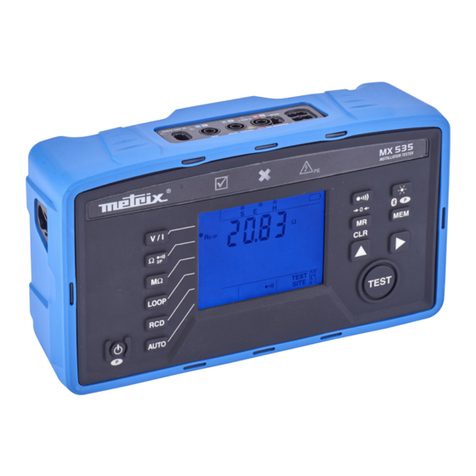
Metrix
Metrix MX 535 User manual
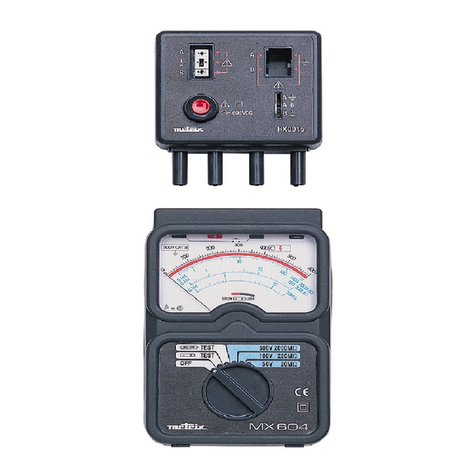
Metrix
Metrix MX 604 User manual

Metrix
Metrix OX 5042 User manual
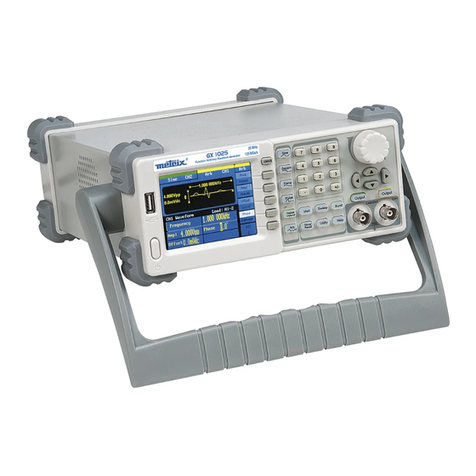
Metrix
Metrix GX 1025 User manual

Metrix
Metrix PX 110 User manual

Metrix
Metrix OX 530 User manual

Metrix
Metrix MX 407 User manual
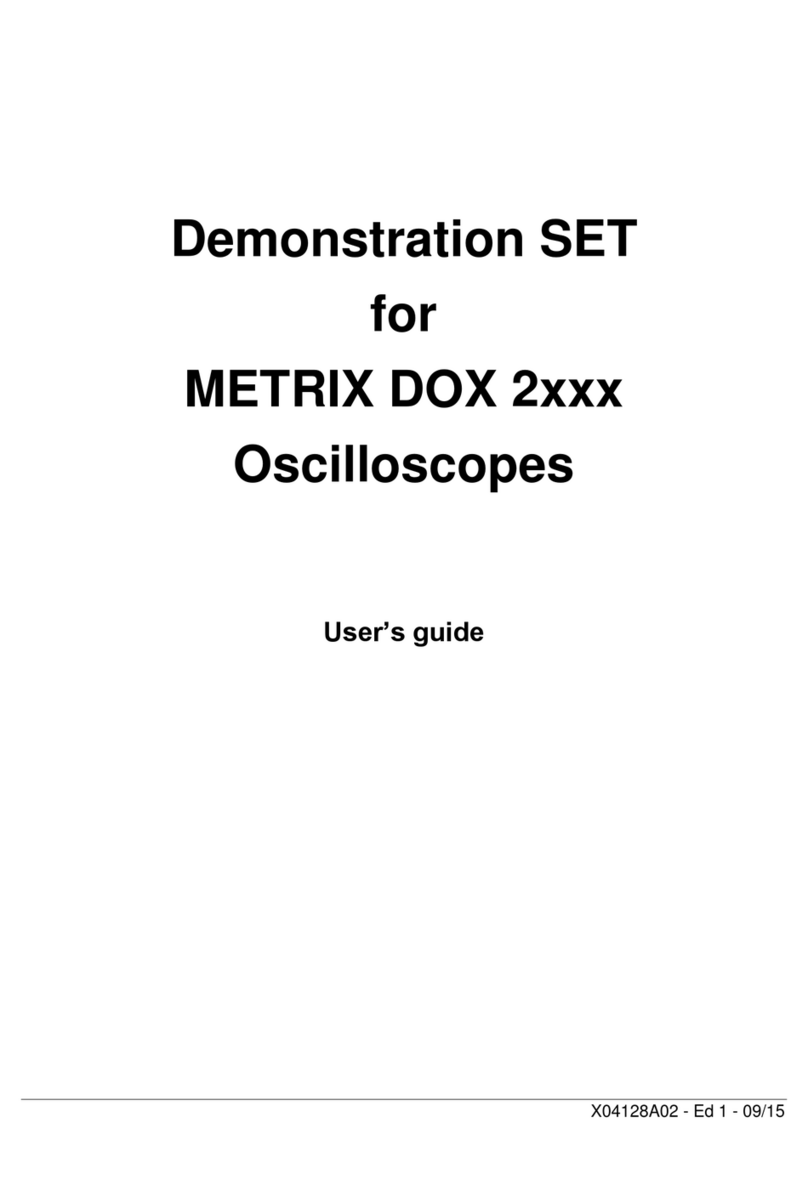
Metrix
Metrix DOX 2 Series User manual
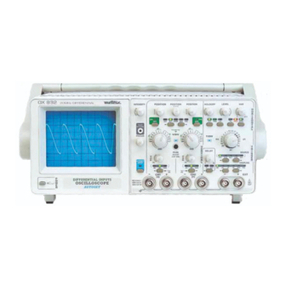
Metrix
Metrix OX 832 User manual

Metrix
Metrix OX 6062-II User manual

Metrix
Metrix MX 535 User manual

Metrix
Metrix MX 59HD User manual
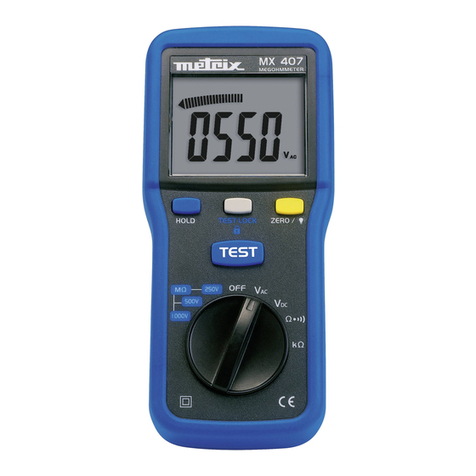
Metrix
Metrix MX 407 User manual
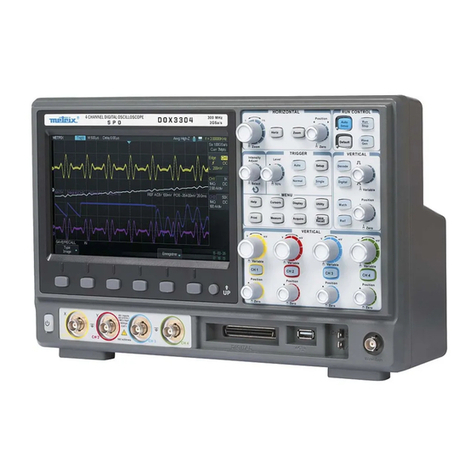
Metrix
Metrix DOX3104 User manual
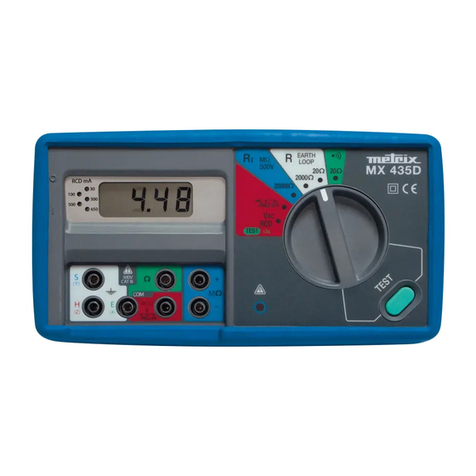
Metrix
Metrix MX 435D User manual
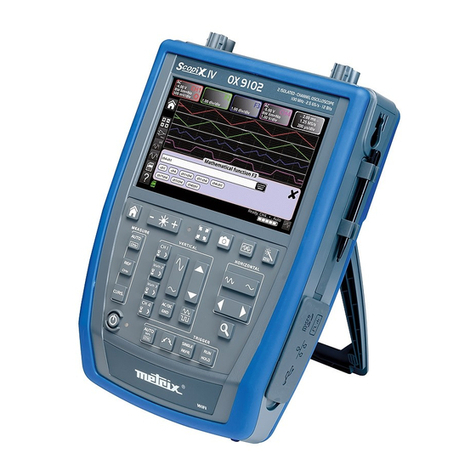
Metrix
Metrix ScopiX IV Series User manual
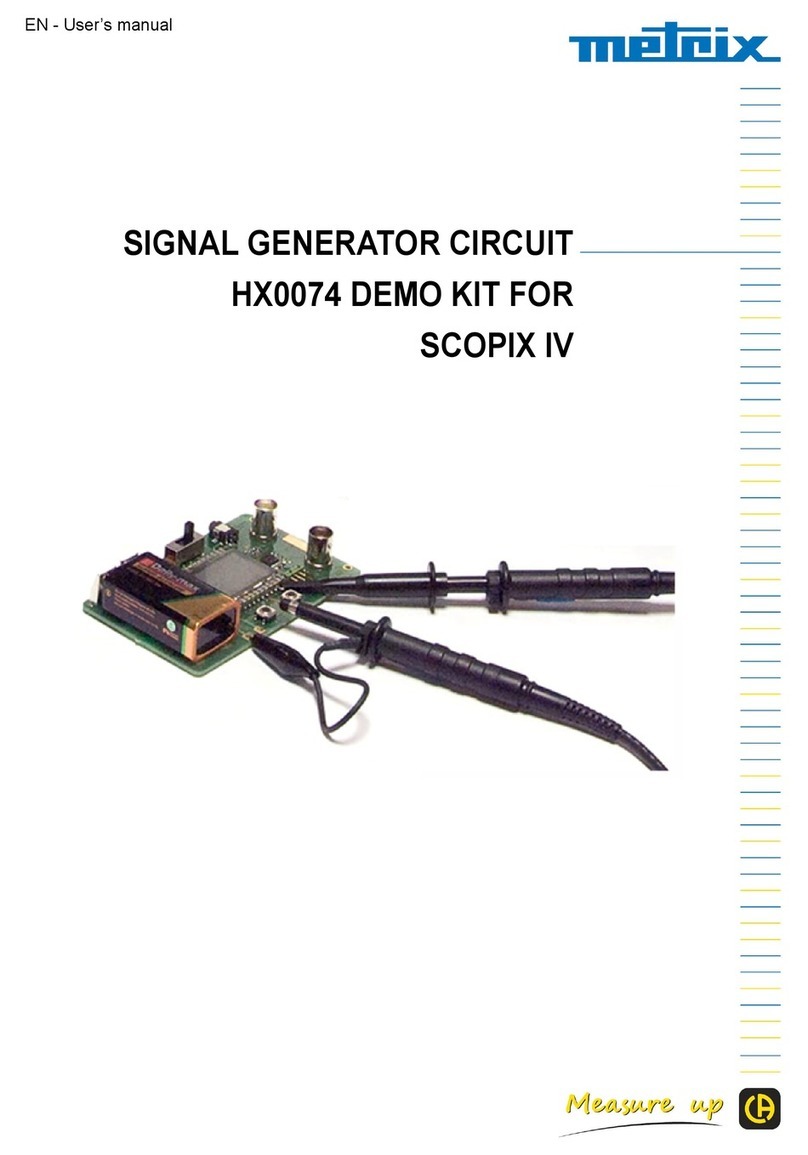
Metrix
Metrix HX0074 User manual
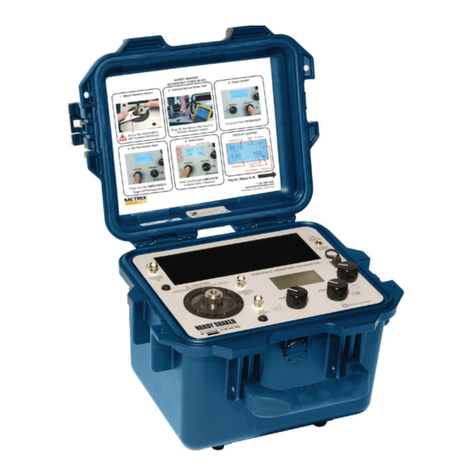
Metrix
Metrix HI-903 User manual

Metrix
Metrix HI 803 Specification sheet
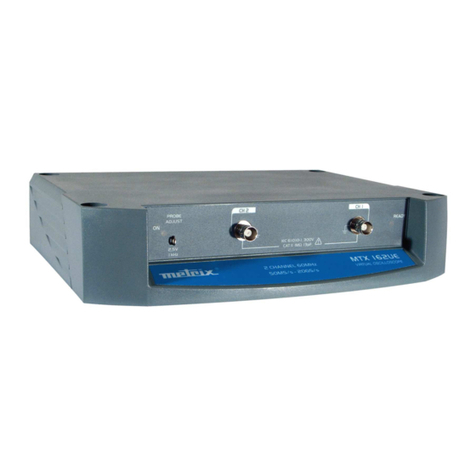
Metrix
Metrix MTX 162UE TX 162UE User manual
